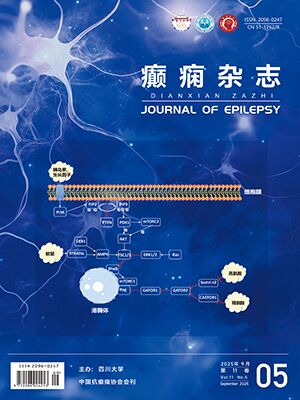| 1. |
Dereymaeker A, Pillay K, Vervisch J, et al. Review of sleep-EEG in preterm and term neonates. Early Hum Dev, 2017, 113: 87-103.
|
| 2. |
Selton D, Andre M, Hascoët JM. Normal EEG in very premature infants: reference criteria. Clin Neurophysiol, 2000, 111(12): 2116-2124.
|
| 3. |
Tsuchida TN, Wusthoff CJ, Shellhaas RA, et al. American clinical neurophysiology society standardized EEG terminology and categorization for the description of continuous EEG monitoring in neonates: report of the american clinical neurophysiology society critical care monitoring committee. J Clin Neurophysiol, 2013, 30(2): 161-173.
|
| 4. |
André M, Lamblin MD, D’Allest AM, et al. Electroencephalography in premature and full-term infants. Developmental features and glossary. Neurophysiol Clin, 2010, 40(2): 59-124.
|
| 5. |
Vasudevan C, Levene M. Epidemiology and aetiology of neonatal seizures. Semin Fetal Neonatal Med, 2013, 18(4): 185-191.
|
| 6. |
Shellhaas RA. Continuous long-term electroencephalography: the gold standard for neonatal seizure diagnosis. Semin Fetal Neonatal Med, 2015, 20(3): 149-153.
|
| 7. |
Shah DK, Mackay MT, Lavery S, et al. Accuracy of bedside electroencephalographic monitoring in comparison with simultaneous continuous conventional electroencephalography for seizure detection in term infants. Pediatrics, 2008, 121(6): 1146-1154.
|
| 8. |
Scher MS, Alvin J, Gaus L, et al. Uncoupling of EEG-clinical neonatal seizures after antiepileptic drug use. Pediatr Neurol, 2003, 28(4): 277-280.
|
| 9. |
Glass HC. Neonatal seizures: advances in mechanisms and management. Clin Perinatol, 2014, 41(1): 177-190.
|
| 10. |
Volpe JJ. Neonatal seizures: current concepts and revised classification. Pediatrics, 1989, 84(3): 422-428.
|
| 11. |
Kanhere S. Recent advances in neonatal seizures. Indian J Pediatr, 2014, 81(9): 917-925.
|
| 12. |
Scher MS, Aso K, Beggarly ME, et al. Electrographic seizures in preterm and full-term neonates: clinical correlates, associated brain lesions, and risk for neurologic sequelae. Pediatrics, 1993, 91(1): 128-134.
|
| 13. |
Mizrahi EM, Kellaway P. Characterization and classification of neonatal seizures. Neurology, 1987, 37(12): 1837-1844.
|
| 14. |
Lai YH, Ho CS, Chiu NC, et al. Prognostic factors of developmental outcome in neonatal seizures in term infants. Pediatr Neonatol, 2013, 54(3): 166-172.
|
| 15. |
Laroia N, Guillet R, Burchfiel J, et al. EEG Background as predictor of electrographic seizures in high-risk neonates. Epilepsia, 2010, 39(5): 545-551.
|
| 16. |
Garfinkle J, Shevell MI. Prognostic factors and development of a scoring system for outcome of neonatal seizures in term infants. Eur J Paediatr Neurol, 2011, 15(3): 222-229.
|
| 17. |
Almubarak S, Wong PK. Long-term clinical outcome of neonatal EEG findings. J Clin Neurophysiol, 2011, 28(2): 185-189.
|
| 18. |
Tsuchida TN. EEG background patterns and prognostication of neonatal encephalopathy in the era of hypothermia. J Clin Neurophysiol, 2013, 30(2): 122-125.
|
| 19. |
Holmes GL, Lombroso CT. Prognostic value of background patterns in the neonatal EEG. J Clin Neurophysiol, 1993, 10(3): 323-352.
|
| 20. |
Berg AT, Berkovic SF, Brodie MJ, et al. Revised terminology and concepts for organization of seizures and epilepsies: report of the ILAE Commission on Classification and Terminology, 2005–2009. Epilepsia, 2010, 51(4): 676-685.
|
| 21. |
Lee IC, Yang JJ, Li SY. AKCNQ2 E515D mutation associated with benign familial neonatal seizures and continuous spike and waves during slow-wave sleep syndrome in Taiwan. J Formos Med Assoc, 2017, 116(9): 711-719.
|
| 22. |
Hart AR, Pilling EL, Alix JJ. Neonatal seizures-part 2: Aetiology of acute symptomatic seizures, treatments and the neonatal epilepsy syndromes. Arch Dis Child Educ Pract Ed, 2015, 100(5): 226-232.
|
| 23. |
Cohen R, Baselvanagaite L, Goldbergstern H, et al. Two siblings with early infantile myoclonic encephalopathy due to mutation in the gene encoding mitochondrial glutamate/H+ symporter SLC25A22. Eur J Paediatr Neurol, 2014, 18(6): 801-805.
|
| 24. |
Backx L, Ceulemans B, Vermeesch JR, et al. Early myoclonic encephalopathy caused by a disruption of the neuregulin-1 receptor ErbB4. Eur J Hum Genet, 2009, 17(3): 378-382.
|
| 25. |
Kato M, Saitsu H, Murakami Y, et al. PIGA mutations cause early-onset epileptic encephalopathies and distinctive features. Neurology, 2014, 82(18): 1587-1596.
|
| 26. |
张赟健, 周水珍. 早发性癫痫性脑病基因突变研究与诊治. 中国实用儿科杂志, 2015(7): 492-497.
|
| 27. |
Beal JC, Cherian K, Moshe SL. Early-onset epileptic encephalopathies: ohtahara syndrome and early myoclonic encephalopathy. Pediatr Neurol, 2012, 47(5): 317-323.
|




